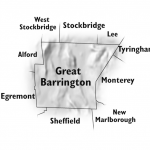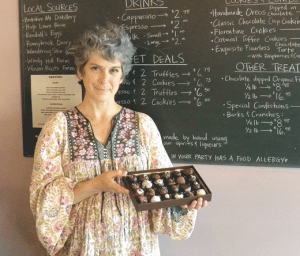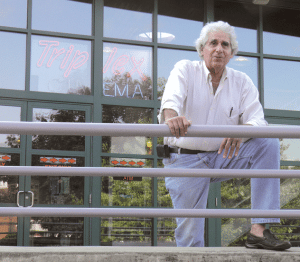Community Profile
Great Barrington Has Become a True Destination
 It’s been difficult for Doria Polinger to keep enough handmade chocolates on the shelves of the store she opened about a month ago on Railroad Street in Great Barrington.
It’s been difficult for Doria Polinger to keep enough handmade chocolates on the shelves of the store she opened about a month ago on Railroad Street in Great Barrington.
“Almost everything I make has sold every day — business has been amazing, even though we are tucked away and many people find us by surprise,” she said about H.R. Zeppelin Fine Handmade Chocolates.
Polinger began looking for the right location for her specialty shop several years ago. The Stockbridge resident and New York City transplant chose Great Barrington because of its “urban feel” and the mix of people who pass through the town. “There are tourists, people who live here year-round, and people who have second homes,” she explained. “Everyone comingles well, which is nice.”

Doria Polinger says her business thrives in Great Barrington, even though many visitors find her by accident.
“Our infrastructure serves residents and people who come here in the summer as well as the surrounding communities,” he told BusinessWest, adding that Great Barrington gets a steady stream of traffic due to its central location.
Route 7 is the town’s Main Street, and Route 23 passes west to east. It combines with Routes 7 and 41 in the western part of town and Route 183 in the eastern part, which also follows a section of Route 7 northward from Route 23, before splitting toward the village of Housatonic. As a result, people from Boston, Upstate New York, and the New York metropolitan area are among the many tourists who visit Great Barringtons’s bustling downtown, where streets are home to small storefronts that sell products ranging from clothing made from hand-woven fabric to homemade food products that include cheese, bread, barbecue sauce, and meat and produce from local farms.
Richard Stanley, who built the four-screen Triplex Cinema downtown and owns other real estate, said the extent of Great Barrington’s vitality can be understood by the fact that, although the town only has 7,700 full-time residents, it is home to 65 restaurants, a number of art galleries, and the well-known Mahaiwe Performing Arts Center, as well as many specialty stores and small businesses.

Richard Stanley says the Triplex Cinema he developed has helped to revitalize the town and turn it into a thriving resort destination.
Town Manager Jennifer Tabakin agrees. “We’re not only a residential community, we are an employment hub — 10,000 people come here to work,” she said, adding that many second homeowners enjoy Great Barrington year-round.
Stanley concurs. “We’re a second-home community for the New York metropolitan area.”
The agricultural community is also thriving. “Many young people are coming back to the area purchasing land to develop as farms, and people are also coming here to learn how to do organic farming,” Stanton said. “We have an internship program for sustainable agriculture, two garden centers, and a lot of landscapers.”
Stanton operates Blue Hill Farms, which is a mixed livestock operation, and says much of the town’s land is under conservation easement and/or agricultural-preservation restrictions.
“Although most of it is being used, there is other land which could be designated as agricultural,” he said, “which would reduce the property taxes on it by 75%.”
Logging Growth
Great Barrington has been honored with many accolades that attest to its character, which include being named the “number-one small town in the U.S.” last year by Smithsonian magazine.
Since its early beginnings, the town has been divided into two sections: the downtown area and Housatonic Village, located on its north side. In its heyday, Housatonic was a booming mill village that provided employment for generations of townsfolk, getting its name from the Housatonic Manufacturing Co. located there.
The village is important in Great Barrington’s history due to its mills, and today, the space within some of them has been transformed into offices, businesses, and apartments with ample room for growth. “There is a fair amount of vacant space available in two of the mill buildings,” Stanley said.
He purchased his first building in town in 1989. “It was just another sleepy place on the map then, and people thought I was nuts,” he told BusinessWest. “It was so quiet, you could shoot a cannon down most of the streets at 5 o’clock.”
But over time, New York residents discovered its beauty and began buying second homes there. In addition, a parking lot was constructed, Stanley built his Triplex Cinema, and the town that had served as a retreat for the wealthy during the Gilded Age was rediscovered. “Today, people come here for the town’s unique combination of beauty, for movies and entertainment, for its restaurants and stores, and for the local art galleries,” Stanley said.

Sean Stanton, a farmer and chair of the town’s select board, shows off one of the Great White Tomatoes he grows at Blue Hill Farms.
And while the community has staged a stunning turnaround, there are projects in various stages of development that could make it even more of a destination.
Topping that list is the $30 million redevelopment of the former New England Log Homes factory site at 100 Bridge St.
“The Community Development Corp. of Southern Berkshire County owned the property for about 20 years,” said Stanley. “It was a brownfields site, but nothing was migrating, so they felt no sense of immediacy to do anything with it.”
But in past few years that changed, and several weeks ago preliminary plans were approved for the eight-acre property that will offer public access to the Housatonic River and provide mixed-use opportunities for businesses, nonprofits, and new restaurants. The plan calls for 50 to 70 new housing units and 40,000 to 50,000 square feet of commercial space.
Stanley sits on the board of directors of the development corporation, and said the state Department of Environmental Protection worked with the panel to determine the best use for the property. “The plan is threefold: to foster commerce on the retail level and create higher-paying jobs and a residential environment,” he said.
The anchor tenant will be Berkshire Co-op Market, which generated $8.3 million in sales last year and has outgrown its current location on Bridge Street. The market is owned by 3,500 members and offers locally grown meat, produce, and other products. It is expected to open next fall in a 10,000-square-foot space, which will include a café.
“The co-op supports local farms and is very active in the community,” said Betsy Andrus, executive director of the Southern Berkshire Chamber of Commerce. “It helps entrepreneurs develop local products and was instrumental in creating a program in the schools after students reached out to them requesting better food. Plus, almost every restaurant in town is farm-to-table. They vary their menus according to the season.”
The redevelopment theme for the site, which is in line with the foodstuffs that will be sold there, includes a wellness center, and Stanley said doctors who practice alternative medicine have already expressed interest in office space.
He added that the site is within walking distance of the downtown, and the board of directors has agreed to think of it as an extension of Main Street because there are buildings available for business use in between.
One of them is the former Searles Middle School, which offers views of the Housatonic River and mountains and sits adjacent to the old Bryant School, which is being redeveloped. It will be the first project of its size to receive the LEED Gold designation in Southern Berkshire County and provides for a ‘destination’ mixed use of the property that respects the character of the historic buildings while enhancing public access of the Housatonic River and creating jobs.
Other development opportunities exist on the former Great Barrington Fairgrounds property. The 50-acre site was recently purchased by the Fair Ground Community Redevelopment Project Inc., a nonprofit group that plans to use it as a sustainable community resource for education, recreation, and agriculture, which would include community gardens and a greenhouse.
More opportunity lies at the Searles Castle, built in 1888, which has been on the market since 2007. The castle contains 40 rooms with more than 60,000 square feet of floor space and 36 fireplaces. After being converted from a private home, it was used as a private girl’s school, conference center, a golf course, and most recently was owned by the John Dewey Academy, which served troubled teens.
“The property has 80 acres of grounds with fountains and ponds,” Andrus explained. “The carriage house alone is beautiful and could be used for businesses.”
Destination Location
Overall, Great Barrington is flourishing. “The future continues to look bright as we get more diversity in terms of people and types of businesses and continue to support our farming community,” Stanley said.
Added Tabakin, “the quality of life here is wonderful. It’s a wonderful place to work, raise a family, and enjoy recreational activities.”
Stanton concurred, noting, “there is a lot going on here.”




